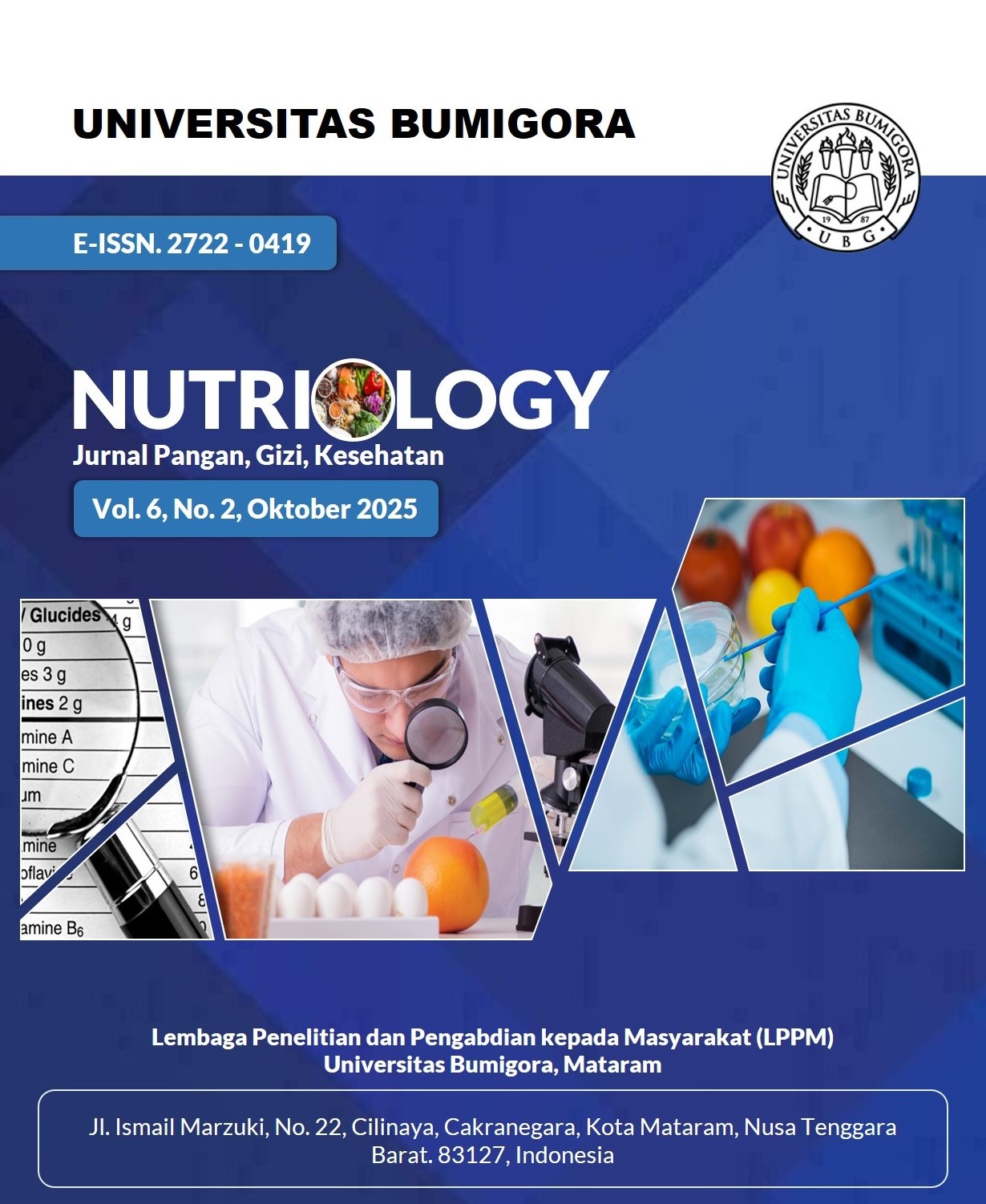Analisis Klaster Dampak Kesehatan Akibat Pandemi Covid-19 Menggunakan Metode K-Means dan C4.5
DOI:
https://doi.org/10.30812/nutriology.v6i2.5659Keywords:
COVID-19, C4.5, data mining, K-Means, clusteringAbstract
The COVID-19 pandemic has had a broad impact on the health system and the socio-economic conditions of communities, including in the Province of West Nusa Tenggara. Inequalities in healthcare access, the prevalence of comorbid diseases, and economic disparities have resulted in varying levels of risk across regions. This study aims to analyze clusters of health impacts resulting from the COVID-19 pandemic in West Nusa Tenggara. The research employed the K-Means and C4.5 Decision Tree methods with a CRISP-DM approach. Secondary data were obtained from the West Nusa Tenggara Provincial General Hospital, the West Nusa Tenggara Health Profile, Statistics Indonesia (BPS) 2022–2023, the 2021 Basic Health Research (Riskesdas), and the World Health Organization (WHO). The variables included COVID-19 cases per 100,000 population, vaccination rates, healthcare facility ratios, prevalence of hypertension and diabetes, and poverty rates. The K-Means results identified three risk clusters: high (Mataram, West Lombok), moderate (Central Lombok, East Lombok), and low (Sumbawa, Dompu, Bima). The C4.5 model achieved an accuracy of 80.67%, with age and comorbidities emerging as dominant factors. These findings highlight the potential of data mining analysis as a foundation for post-pandemic mitigation policies and strengthening regional health system resilience.
References
[1] World Health Organization (WHO), “WHO COVID-19 dashboard,” Geneva, 2023. [Online]. Available: https://data.who.int/dashboards/covid19/cases?n=c
[2] Kementerian Kesehatan RI, “LAPORAN PERTEMUAN AFTER ACTION REVIEW (AAR) COVID-19,” Jakarta, 2023.
[3] International Labour Organisation, Dampak Sosial Ekonomi Pandemi COVID-19 di Indonesia, Analisis Pasar Kerja dan Rekomendasi Kebijakan, 1st ed. Jakarta: International Labour Organization 2022 Terbitan, 2022. [Online]. Available: www.ilo.org/publns.
[4] Badan Pusat Statistik, Statistik Indonesia 2023: Keadaan sosial ekonomi dan dampak pandemi COVID-19. BPS RI, 2023.
[5] M. Rahman, T. Wulandari, and F. Siregar, “Assessment of regional health facility readiness in Nusa Tenggara Barat during the COVID-19 pandemic,” Indonesian Journal of Health Systems Research, vol. 9, no. 1, pp. 33–48, 2023.
[6] L. Zhang, H. Xu, and Q. Li, “Clustering analysis of COVID-19 spread patterns in China using K-Means algorithm,” Scientific Reports, vol. 12, p. 11045, 2022, doi: 10.1038/s41598-022-15291-8.
[7] A. Alessa and M. Faezipour, “Predicting COVID-19 patient mortality using decision tree algorithms,” Journal of Healthcare Informatics Research, vol. 5, no. 3, pp. 234–247, 2021, doi: 10.1007/s41666-021-00094-4.
[8] S. Ghosh, S. Mondal, and S. Ghosh, “Hybrid K-Means and decision tree model for COVID-19 risk classification: A data-driven approach,” Journal of Applied Data Science, vol. 3, no. 4, pp. 211–225, 2022, doi: 10.1016/j.jads.2022.04.008.
[9] A. P. Sari, R. Nugraha, and M. Yusuf, “Socioeconomic determinants of COVID-19 spread in Indonesia: A multivariate analysis,” Journal of Public Health in Indonesia, vol. 7, no. 3, pp. 211–220, 2022.
[10] Rumah Sakit Umum Provinsi Nusa Tenggara Barat, “Laporan tahunan pelayanan kesehatan dan kasus COVID-19 tahun 2023,” 2023, RSUP NTB, Mataram.
[11] Dinas Kesehatan Provinsi Nusa Tenggara Barat, “Profil Kesehatan Provinsi NTB Tahun 2023,” 2023.
[12] Kementerian Kesehatan Republik Indonesia, “Riset kesehatan dasar (Riskesdas) 2023,” 2023, Badan Kebijakan Pembangunan Kesehatan, Jakarta.
[13] A. Alessa and M. Faezipour, “Clustering and prediction of COVID-19 using machine learning techniques,” IEEE Access, vol. 9, pp. 123900–123911, 2021, doi: 10.1109/ACCESS.2021.3109056.
[14] R. Jayawardena, P. Sooriyaarachchi, M. Chourdakis, C. Jeewandara, and P. Ranasinghe, “Enhancing immunity in viral infections, with special emphasis on COVID-19: A review,” Diabetes & Metabolic Syndrome: Clinical Research & Reviews, vol. 14, no. 4, pp. 367–382, 2020, doi: 10.1016/j.dsx.2020.04.015.
[15] P. C. Calder, A. C. Carr, A. F. Gombart, and M. Eggersdorfer, “Optimal nutritional status for a well-functioning immune system is an important factor to protect against viral infections,” Nutrients, vol. 12, no. 4, p. 1181, 2020, doi: 10.3390/nu12041181.
[16] F. Zhou et al., “Clinical course and risk factors for mortality of adult inpatients with COVID-19 in Wuhan, China: A retrospective cohort study,” The Lancet, vol. 395, no. 10229, pp. 1054–1062, 2020, doi: 10.1016/S0140-6736(20)30566-3.
[17] S. Richardson, J. S. Hirsch, M. Narasimhan, J. M. Crawford, T. McGinn, and K. W. Davidson, “Presenting characteristics, comorbidities, and outcomes among 5700 patients hospitalized with COVID-19 in the New York City area,” JAMA, vol. 323, no. 20, pp. 2052–2059, 2020, doi: 10.1001/jama.2020.6775.
[18] J. Zhu, H. Zhang, and Y. Zhao, “Data-driven hybrid models for COVID-19 severity classification using clustering and decision tree,” Computer Methods and Programs in Biomedicine, vol. 221, p. 106886, 2022, doi: 10.1016/j.cmpb.2022.106886.
[19] N. P. Lestari, D. Rahmawati, and A. Wahyudi, “Spatial clustering analysis of COVID-19 mortality and health service capacity in Indonesia,” Jurnal Epidemiologi Indonesia, vol. 7, no. 1, pp. 55–68, 2023.
[20] A. P. Rossi et al., “The Role of Obesity, Body Composition, and Nutrition in COVID-19 Pandemia: A Narrative Review,” Nutrients, vol. 14, no. 17, pp. 1–15, 2022, doi: 10.3390/nu14173493.
[21] P. C. Calder, “Nutrition and immunity: lessons for COVID-19,” Nutrition and Diabetes, vol. 11, no. 1, pp. 1–8, 2021, doi: 10.1038/s41387-021-00165-0.
[22] J. Antwi, B. Appiah, B. Oluwakuse, and B. A. Z. Abu, “The Nutrition-COVID-19 Interplay: a Review,” Current Nutrition Reports, vol. 10, no. 4, pp. 364–374, 2021, doi: 10.1007/s13668-021-00380-2.
[23] N. Rahmiati and R. Sari, “Nutrition and public health challenges during COVID-19: Lessons from local communities,” Nutriology Journal, vol. 2, no. 2, pp. 45–53, 2021.
[24] J. Han, M. Kamber, and J. Pei, Data Mining: Concept and Technique, 4th ed. Cambridge: Elsevier, 2012.
[25] M. Laatifi et al., “Machine learning approaches in Covid-19 severity risk prediction in Morocco,” Journal of Big Data, vol. 9, no. 1, 2022, doi: 10.1186/s40537-021-00557-0.
[26] M. T. Ribeiro, S. Singh, and C. Guestrin, “‘Why should i trust you?’ Explaining the predictions of any classifier,” Proceedings of the ACM SIGKDD International Conference on Knowledge Discovery and Data Mining, vol. 13-17-August-2016, pp. 1135–1144, 2016, doi: 10.1145/2939672.2939778.
Downloads
Published
Issue
Section
License
Copyright (c) 2025 Karina Anindita, Anak Agung Ngurah Bagus Adhitya Wirakusuma, Kristopher May Pamudji, Dini Wurnaning Budi, I Komang Reka Yudha

This work is licensed under a Creative Commons Attribution 4.0 International License.










